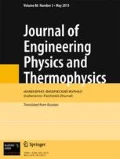On the basis of the consideration of the boundary-value problem for the generalized equation of heat conduction in bounded nonuniform spaces with Dirichlet, Neumann, and Robin boundary conditions, corresponding sequences of boundary characteristics have been obtained. For each of these sequences, definite integro-differential representations (relations) have been constructed. It has been shown that approximate analytical solutions can be obtained for bounded nonuniform regions with variable transfer coefficients in the Cartesian, cylindrical, and spherical coordinate systems. On the basis of systems of algebraic equations, approximate analytical solutions have been constructed with approximately equal accuracies independently of the calculation scheme used (with the introduction of the temperature-disturbance front or without it, i.e., by multiple integration of the heat-conduction equation over the whole computational region). These solutions have a negligibly small error and, therefore, can be considered as conditionally exact.
Similar content being viewed by others
References
V. A. Kot, Multiple integration of the heat-conduction equation for a space bounded from the inside, J. Eng. Phys. Thermophys., 89, Issue 2, 369–390 (2016).
V. A. Kot, Method of boundary characteristics, J. Eng. Phys. Thermophys., 88, Issue 6, 1390–1345 (2015).
T. R. Goodman, Application of integral methods to transient nonlinear heat transfer, Adv. Heat Transf., Academic Press, New York (1964), Vol. 1, pp. 51–122.
A. V. Luikov, Heat Conduction Theory [in Russian], Vysshaya Shkola, Moscow (1967).
M. N. Ozisic, Heat Conduction, John Wiley & Sons, Inc., New York (1993).
J. Crank, The Mathematics of Diffusion, Clarendon Press, Oxford (1975).
G. I. Barenblatt and B. M. Levitan, Some boundary problems for the equation of turbulent heat conduction, Izv. Akad. Nauk SSSR, Ser. Mat., No. 16, 253–280 (1952).
É. M. Kartashov, A class of integral transformations for the generalized equation of nonstationary heat conduction, J. Eng. Phys. Thermophys., 81, Issue 1, 129–137 (2008).
T. G. Myers, An approximate solution method for boundary layer flow of a law-power fluid over a fl at plate, Int. J. Heat Mass Transf., 53, No. 11, 2337–2346 (2010).
É. M. Kartashov, Analytical Methods in the Heat-Conduction Theory of Solids [in Russian], Vysshaya Shkola, Moscow (2001).
H. S. Carslow and H. S. Jaeger, Conduction of Heat in Solids, Oxford University Press, Oxford, UK (1992).
D. Langford, The heat balance integral method, Int. J. Heat Mass Transf., 16, No. 12, 2424–2428 (1973).
T. R. Goodman, The heat-balance integral — further considerations and refinements, Trans. ASME, Ser. C, No. 1, 83–93 (1961).
J. Baker and P. Graves-Morris, Padé Approximants [Russian translation], Mir, Moscow (1986).
Author information
Authors and Affiliations
Additional information
Translated from Inzhenerno-Fizicheskii Zhurnal, Vol. 89, No. 4, pp. 983–1006, July–August, 2016.
Rights and permissions
About this article
Cite this article
Kot, V.A. Boundary Characteristics for the Generalized Heat-Conduction Equation and Their Equivalent Representations. J Eng Phys Thermophy 89, 985–1007 (2016). https://doi.org/10.1007/s10891-016-1461-1
Received:
Published:
Issue Date:
DOI: https://doi.org/10.1007/s10891-016-1461-1



